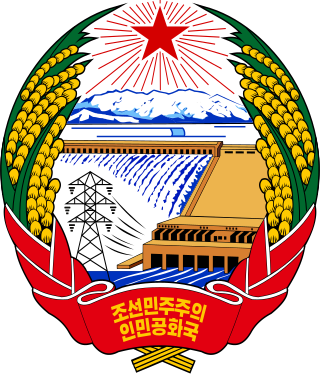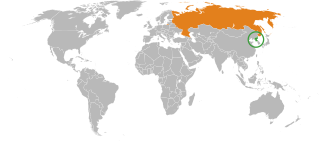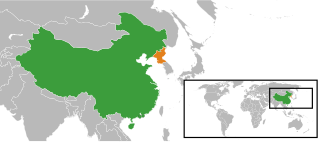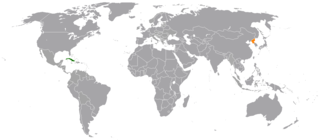| |||||
| Centuries: | |||||
|---|---|---|---|---|---|
| Decades: | |||||
| See also: | Other events in 1961 Years in North Korea Timeline of Korean history 1961 in South Korea | ||||
Events from the year 1961 in North Korea .
| |||||
| Centuries: | |||||
|---|---|---|---|---|---|
| Decades: | |||||
| See also: | Other events in 1961 Years in North Korea Timeline of Korean history 1961 in South Korea | ||||
Events from the year 1961 in North Korea .
4th Congress of the Workers' Party of Korea

North Korea has diplomatic relations with 160 states. The country's foreign relations have been dominated by its conflict with South Korea and its historical ties to the Soviet Union. Both the government of North Korea and the government of South Korea claim to be the sole legitimate government of the whole of Korea. The de facto end of the Korean War left North Korea in a military confrontation with South Korea along the Korean Demilitarized Zone.

Kim Jong Il was a North Korean politician who was the second supreme leader of North Korea. He led North Korea from the death of his father Kim Il Sung in 1994 until his death in 2011, when he was succeeded by his son, Kim Jong Un. Afterwards, Kim Jong Il was declared Eternal General Secretary of the Workers' Party of Korea (WPK).

Mount Myohyang is a mountain in North Korea. It is named for the mystic shapes and fragrances found in the area. It is a sacred site as, according to legend, it was the home of King Tangun, forefather of the Korean people.

The Kumsusan Palace of the Sun, formerly the Kumsusan Memorial Palace (금수산기념궁전), is a building near the northeast corner of the city of Pyongyang that serves as the mausoleum for Kim Il Sung, first Supreme Leader and founder of North Korea, and for his son Kim Jong Il, both posthumously designated as the Eternal leaders of North Korea.

The President of the State Affairs Commission of the Democratic People's Republic of Korea, alternatively styled "President of State Affairs" in official translations, is the supreme leader and head of state of North Korea. The president chairs the State Affairs Commission (SAC), which is the highest leadership institution in North Korea, and serves as the commander-in-chief of the North Korean armed forces.

The Soviet Union was the first to recognize North Korea on October 12, 1948, shortly after the proclamation, as the sole legitimate authority in all of Korea. The Soviet Union supported North Korea during the Korean War. North Korea was founded as part of the Communist bloc, and received major Soviet military and political support. The comprehensive personality cult around North Korea's ruling family was heavily influenced by Stalinism. China and the Soviet Union competed for influence in North Korea during the Sino-Soviet split in the 1960s, as North Korea tried to maintain good relations with both countries.

Mongolia–North Korea relations are the historic and current bilateral relations between Mongolia and the Democratic People's Republic of Korea.

The bilateral relations between the People's Republic of China (PRC) and the Democratic People's Republic of Korea (DPRK) have been generally friendly, although they have been somewhat strained in recent years because of North Korea's nuclear program. They have a close special relationship. China and North Korea have a mutual aid and co-operation treaty, signed in 1961, which is currently the only defense treaty China has with any nation. China's relationship with North Korea is its only formal alliance.

Kim Il Sung was a North Korean politician, revolutionary, and military leader. He founded the Democratic People's Republic of Korea, commonly known as North Korea, which he led as Supreme Leader from its establishment in 1948 until his death in 1994. Afterwards, he was succeeded by his son Kim Jong Il and was declared Eternal President.

The International Friendship Exhibition is a large museum complex located at Myohyangsan, North Pyongan Province, North Korea. It is a collection of halls that house gifts presented to former leaders Kim Il Sung and Kim Jong Il from various foreign dignitaries. The protocol of gift-giving is well established in Korean culture.

The Treaty on Friendship, Cooperation and Mutual Assistance between China and the DPRK is a friendship and security treaty between China and North Korea. The treaty was signed on 11 July 1961 in Beijing by Chinese Premier Zhou Enlai and North Korean Premier Kim Il Sung.

The Battle of Pochonbo was an event which occurred in northern Korea, Empire of Japan on 4 June 1937, when Korean and Chinese guerrillas commanded by Kim Il Sung attacked and defeated a Japanese detachment during the anti-Japanese armed struggle in Korea. The battle holds an important place in North Korea.

Central African Republic–North Korea relations refers to the current and historical relationship between the Central African Republic and the North Korea (DPRK). Neither country maintains an embassy in their respective capitals.
Events from the year 1974 in North Korea.
Events from the year 1972 in North Korea.
Events from the year 1971 in North Korea.
Events from the year 1953 in North Korea.

Cuba–North Korea relations are the bilateral relations between Cuba and North Korea.
The July 4 South–North Joint Statement, also known as the July 4 South–North Joint Communiqué, was the first joint statement by the governments of South Korea and North Korea, signed on July 4, 1972. The signatories of the statement were Lee Hu-rak and Kim Yong-ju, who represented the delegations from the south and north, respectively.

Visual depictions of Kim Il Sung have been commonplace in North Korea since the 1940s following the example of Joseph Stalin in the Soviet Union and Mao Zedong in China. The display of Kim Il Sung portraits was made mandatory at homes in the 1970s. In the past, they were mandatory in certain public places as well, such as factories, schools, airports, railway stations, and rail and subway carriages. At present, they no longer appear in means of transport, not even in some new buildings. Portraits of Kim Jong Il have been hung next to Kim Il Sung since the late 1970s. A portrait of Kim Jong Un was displayed for the first time in public in 2018.